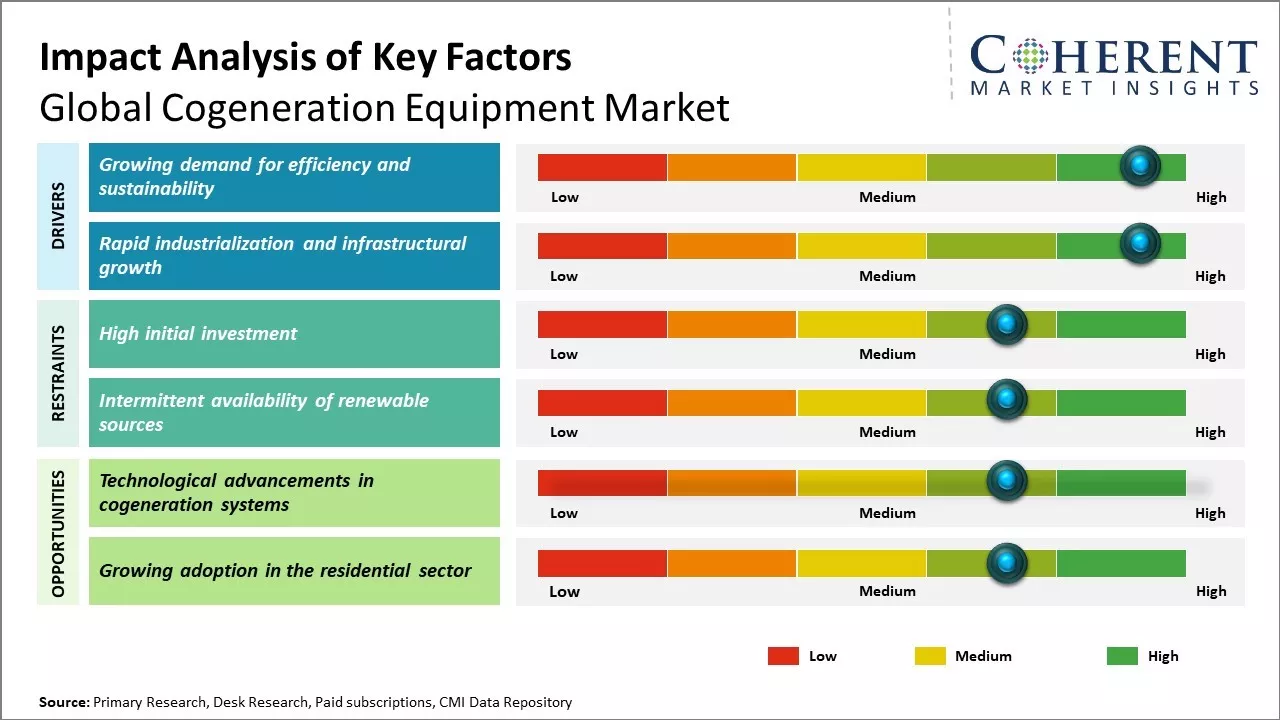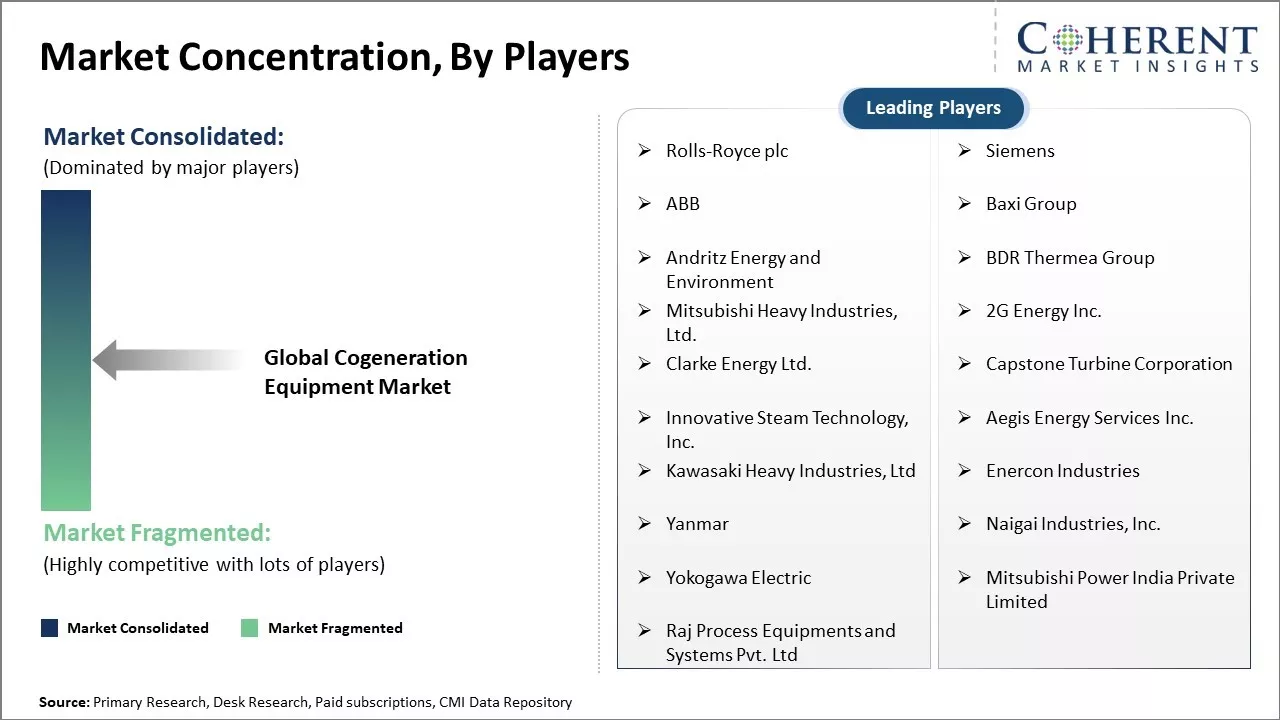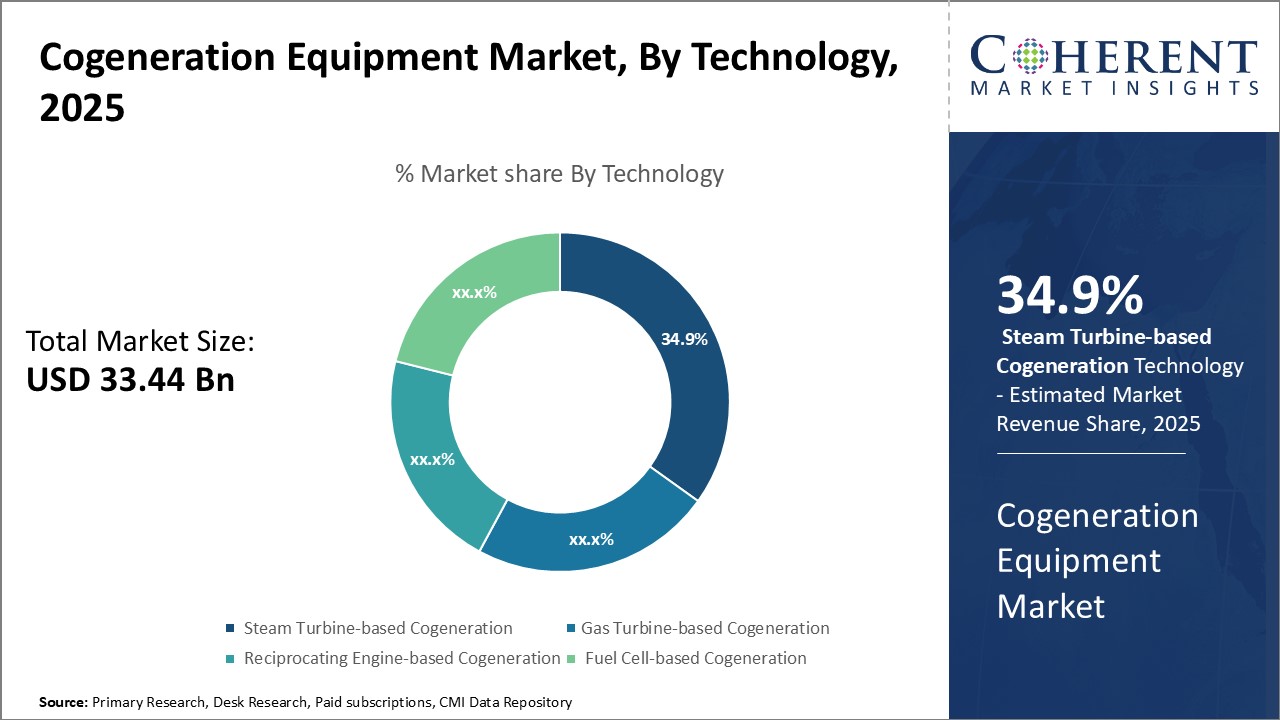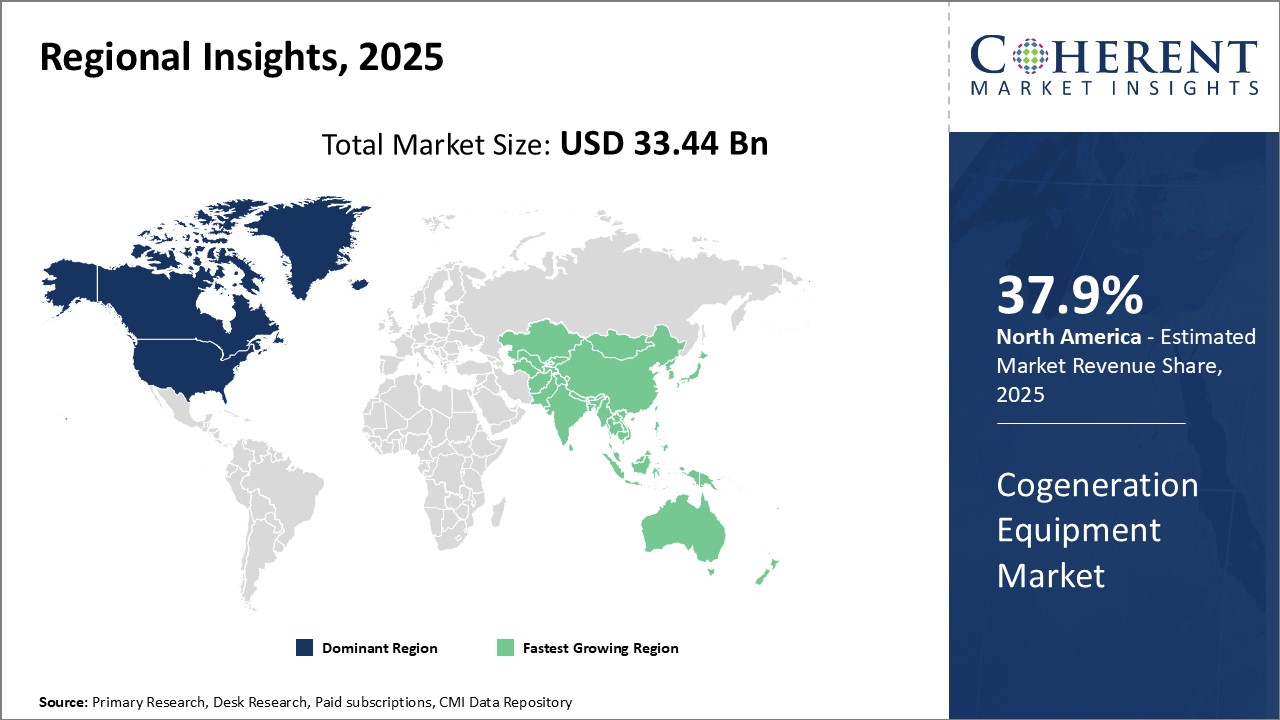The cogeneration equipment market is estimated to be valued at USD 33.44 Bn in 2025 and is expected to reach USD 63.97 Bn by 2032, exhibiting a compound annual growth rate (CAGR) of 9.7% from 2025 to 2032.

Discover market dynamics shaping the industry: Request sample copy
The cogeneration equipment market is witnessing positive trends owing to the growing demand for clean and reliable power. Several factors such as stringent government regulations toward reducing carbon footprint, tax incentives on cogeneration plants, rising focus on efficient power production, and growing industrialization & urbanization in emerging nations are expected to drive the demand for cogeneration equipment. Moreover, the ability of cogenerated plants to minimize power wastage and maximize fuel efficiency is encouraging industries and commercial establishments to incorporate these systems. On the other hand, high initial investment and component replacement costs associated with cogeneration systems might hinder the market growth. However, the development of innovative and cost-effective products is likely to create new opportunities in the coming years.
Growing demand for efficiency and sustainability
The cogeneration equipment market is being driven significantly by the rising demand for efficient power generation technologies that can help reduce carbon emissions. Cogeneration systems, also known as combined heat and power systems, offer major advantages over conventional methods of separate electricity and heat production by utilizing the waste heat from power generation for various industrial and commercial applications like space heating or cooling. This dual mode of operation provides substantially higher fuel efficiency compared to generating the same amount of power and heat separately from different systems. As environmental concerns rise and organizations aim to lower their carbon footprint, cogeneration has emerged as a versatile and sustainable solution to meet baseload energy needs in a cost-effective as well as eco-friendly manner. Various countries and international bodies have also formulated regulatory policies and financial incentives to boost cogeneration adoption. This is encouraging more end users to implement cogeneration projects across diverse industry verticals.

Get actionable strategies to beat competition: Request sample copy
Rapid industrialization and infrastructural growth
Another key growth driver for the cogeneration equipment market is the immense infrastructure development taking place worldwide. There is rising construction of new industrial plants, commercial buildings, data centers, and other large-scale facilities that require round-the-clock power and thermal energy supply. Cogeneration systems are increasingly being utilized to fulfill the combined power and heating/cooling load of these expanding infrastructural facilities in an integrated manner. Moreover, with ongoing industrialization in developing economies and regions, the energy demand from the manufacturing sector is also witnessing strong growth. Cogeneration offers manufacturers a reliable and cost-effective means to meet their high steam and electricity needs for various industrial processes and machinery simultaneously. The intensifying industrial and infrastructural activities thus contributes significantly to the rising global sales of cogeneration equipment over the forecast period.
Key Takeaways from Analyst:
The cogeneration equipment market is expected to witness significant growth over the forecast period driven by the rising demand for reliable and uninterrupted power supply globally. The North America region, , will dominate the market owing to rapid industrialization and increasing energy needs of the burgeoning population in these countries. Stringent emission norms by regulatory bodies to curb carbon emissions will further propel the adoption of cogeneration plants. However, high initial investment for setup and component maintenance may hinder the market expansion to some extent.
Rise of distributed power generation using cogeneration will open new revenue streams for market players. Governments across regions are providing incentives and subsidies for cogeneration projects which will augment the business prospects. However, lack of cogeneration awareness may pose challenges especially in developing nations.
Manufacturers are innovating in plant designs with advanced technologies to improve efficiencies. Demand from data centers and pharmaceutical industries needing reliable power will drive specialized product offerings. The need for the modernization of aging power infrastructure offers lucrative growth prospects. European nations are replacing old cogeneration units to meet stringent emission norms. Emerging applications in waste heat recovery are expanding application scope for cogeneration.
Market Challenges: High initial investment
One of the major factors holding back the growth of cogeneration equipment market is the high initial capital cost involved in setting up a cogeneration system. Cogeneration plants require significant upfront investment for purchasing equipment such as prime movers, generators, heat recovery systems, etc. Additionally, costs associated with installation, commissioning, and grid connection further contribute to overall capital expenditure.
Market Opportunities: Technological advancements in cogeneration systems
Technological advancements are emerging as a great opportunity in the cogeneration equipment market. Cogeneration or combined heat and power (CHP) is an efficient system for the simultaneous production of electrical and thermal energy from a single fuel source. Traditionally, separate systems were used to produce electricity and heat which led to waste of unused thermal energy during power generation. However, new cogeneration systems are being designed to maximize fuel efficiency and reduce carbon footprint. Advanced technologies like combined cycle turbines are allowing higher fuel efficiency. These turbines use natural gas or biomass to power a gas turbine for electricity production. The exhaust heat is then recovered to raise steam in a boiler which powers a steam turbine. This doubles the total efficiency compared to separate systems. Fuel cells are another promising technology that can be used for on-site cogeneration. Fuel cell CHP systems use an electrochemical process rather than combustion to generate power and produce very low emissions. Improved material science is helping develop more durable and compact fuel cell stacks.

Discover high revenue pocket segments and roadmap to it: Request sample copy
Insights by Technology: Reliability and efficiency drive the adoption of steam turbine technology
In terms of technology, steam turbine-based cogeneration is expected to contribute 34.9% share of the market in 2025, owing to its reliability and high thermodynamic efficiency. Steam turbine technology has been an integral part of power generation systems for over a century. Its mechanical simplicity and ability to leverage high temperature steam makes it highly advantageous for cogeneration applications compared to other technologies. Steam turbines can effectively utilize low, medium, and high-pressure steam to produce rotational energy that can power a generator for electricity production. This enables steam turbine cogeneration systems to maximally extract useful thermal energy from fuel. They feature low maintenance requirements and minimal moving parts, resulting in high reliability even with continuous heavy-duty operation. Their lubrication needs are also minimal compared to engines, further improving overall equipment effectiveness. Steam turbine systems can flexibly adjust power output variation according to demand by controlling steam flow, load and throttle pressure. This load-following capability makes them suitable for baseload as well as peak power supply. Manufacturers have further optimized steam turbine designs for cogeneration through advanced materials, component coatings and precision manufacturing. This has enhanced efficiency, emission performance and service life of steam turbine cogeneration packages.
Their ability to efficiently use low-grade heat sources like biomass, municipal solid waste, or waste heat from industrial processes further boosts the economic and environmental value proposition of steam turbine cogeneration systems. Established global supply chains also ensure low capital and operating costs through economies of scale. With their inherent technical advantages, steam turbine technology continues to dominate large-scale industrial and district heating cogeneration applications.
Insights by Fuel Type: Natural abundance and infrastructure drive the widespread adoption of natural gas
In terms of fuel type, natural gas is expected to contribute 39.3% share of the market in 2025 owing to its wide availability and existing transport infrastructure. Natural gas has established itself as the preferred fuel for modern cogeneration systems due to multiple advantages over competing alternatives. Natural gas power plants emit lower levels of carbon dioxide, sulfur dioxide, mercury and particulate matter compared to coal-fired or oil-fired systems. This improves local air quality and reduces environmental footprint of cogeneration. Additionally, natural gas fuels contain negligible radioactive or toxic constituents unlike nuclear or some biomass fuels. The clean-burning properties of natural gas are increasingly important as emission regulations tighten globally.
Well-developed pipeline networks and reliable liquefied natural gas supply chains ensure on-demand gas supply and transportation. This infrastructure reduces procurement and logistical risks compared to intermittent renewable fuels. Natural gas is also storable as compressed or liquefied forms, enabling steady fuel supply for baseload cogeneration applications. Abundant shale gas reserves have further boosted domestic supply security and competitive gas pricing in key markets. Improving extraction technologies continue unlocking hitherto inaccessible reserves. Growing global LNG trade is also enlarging the worldwide gas market. Widespread availability, competitive pricing and reliable delivery infrastructure give natural gas distinct economic and operational advantages over other fuel alternatives.
Insights by Application: Reliable power needs drive commercial sector adoption
In terms of application, commercial is expected to contribute 43% share of the market in 2025, due to high demands for reliable and uninterrupted power supply. Commercial buildings such as hospitals, hotels, retail complexes, offices, and educational institutions require sustained indoor climate control and other energy-intensive services throughout the day. Unplanned power outages or fluctuations can significantly impact operations, occupant comfort, and safety in these facilities.
Cogeneration is increasingly adopted in commercial facilities to ensure dependable, on-site power generation as a backup or complement to main grid supply. The distributed energy model of cogeneration enhances energy security by immunizing critical commercial facilities from grid failures caused by natural disasters, technical faults, or other disruptions. On-site CHP systems can immediately take over full facility loads during grid outages to prevent business continuity risks. Cogeneration also boosts commercial facility efficiency by capturing waste heat from power generation for high-value applications like space heating, ventilation, air conditioning, hot water supply, and food service operations. The overall primary energy savings and operational cost reductions achieved enhance viability of commercial enterprises. Integrated cogeneration perfectly aligns with commercial sector goals of reliability, sustainability, and profitability through optimized energy management.

Need a Different Region or Segment? Customize now
North America has been the dominant region in the global cogeneration equipment market for over a decade. The region is expected to hold with 37.9% of the market share in 2025. The industrial sector in the U.S. and Canada has driven heavy demand for cogeneration systems to improve energy efficiency and reduce costs. Many industries such as manufacturing, healthcare, oil & gas, and food processing have installed cogeneration power plants to meet their baseload electricity and thermal energy needs. The stringent emission norms by EPA have compelled industrial plants to replace aging boilers with innovative cogeneration systems.
Cogeneration provides an attractive option to decarbonize industrial operations in North America. Leading manufacturers offer tailored cogeneration solutions for industries to seamlessly integrate renewable energy sources. The region is also witnessing a rise in customized cogeneration projects to generate power from waste heat and biomass. Supported by increasing R&D investments, newer cogeneration technologies for industries such as organic Rankine cycle are being commercialized. Overall, the strong industrial presence makes North America highly lucrative for cogeneration equipment providers.
On the other hand, the Asia Pacific region has emerged as the fastest growing market for cogeneration equipment globally. Rapid industrialization and rising energy demands from China, India, Japan, and South Korea are major factors driving the regional growth. Countries in Asia Pacific are also witnessing increased focus toward renewable energy and carbon reduction goals set by the Paris Agreement. This is encouraging industries to incorporate innovative cogeneration technologies. Additionally, affordable labor costs and evolving regulatory framework in many developing nations have attracted major global players to set up manufacturing facilities.
Rising exports of cogeneration systems from China, Japan, and South Korea have positioned Asia Pacific as an important regional hub. Domestic industries are increasingly procuring equipment locally for their cogeneration projects in a cost-effective manner. The upcoming policies by governments are likely to incentivize and promote wider adoption of cogeneration to achieve long-term sustainability objectives. Overall, the Asia Pacific region presents immense growth opportunities for cogeneration equipment providers over the coming years.
Cogeneration Equipment Market Report Coverage
| Report Coverage | Details | ||
|---|---|---|---|
| Base Year: | 2024 | Market Size in 2025: | USD 33.44 Bn |
| Historical Data for: | 2020 To 2024 | Forecast Period: | 2025 To 2032 |
| Forecast Period 2025 to 2032 CAGR: | 9.7% | 2032 Value Projection: | USD 63.97 Bn |
| Geographies covered: |
|
||
| Segments covered: |
|
||
| Companies covered: |
Rolls-Royce plc, Siemens, ABB, Baxi Group, Andritz Energy and Environment, BDR Thermea Group, Mitsubishi Heavy Industries, Ltd., 2G Energy Inc., Clarke Energy Ltd., Capstone Turbine Corporation, Innovative Steam Technology, Inc., Aegis Energy Services Inc., Kawasaki Heavy Industries, Ltd, Enercon Industries, Yanmar, Naigai Industries, Inc., Yokogawa Electric, Mitsubishi Power India Private Limited, and Raj Process Equipments and Systems Pvt. Ltd |
||
| Growth Drivers: |
|
||
| Restraints & Challenges: |
|
||
Uncover macros and micros vetted on 75+ parameters: Get instant access to report
*Definition: The cogeneration equipment market involves technologies that produce both heat and power from a single fuel source. Cogeneration systems, also known as combined heat and power systems, capture heat that would otherwise be wasted from power generation and put it to useful purposes like heating, cooling and processing. The key equipment in cogeneration includes prime movers like gas turbines, steam turbines, reciprocating engines and fuel cells. Other core equipment are heat recovery steam generators, heat exchangers and electrical interconnection equipment. Cogeneration offers improved energy efficiencies compared to separate production of heat and power.
Share
Share
About Author
Yash Doshi is a Senior Management Consultant. He has 12+ years of experience in conducting research and handling consulting projects across verticals in APAC, EMEA, and the Americas.
He brings strong acumen in helping chemical companies navigate complex challenges and identify growth opportunities. He has deep expertise across the chemicals value chain, including commodity, specialty and fine chemicals, plastics and polymers, and petrochemicals. Yash is a sought-after speaker at industry conferences and contributes to various publications on topics related commodity, specialty and fine chemicals, plastics and polymers, and petrochemicals.
Missing comfort of reading report in your local language? Find your preferred language :
Transform your Strategy with Exclusive Trending Reports :
Frequently Asked Questions
Joining thousands of companies around the world committed to making the Excellent Business Solutions.
View All Our Clients
US Reciprocal Tax Impact Analysis On Cogeneration Equipment Market
Stay updated on tariff changes with expert insights and timely information